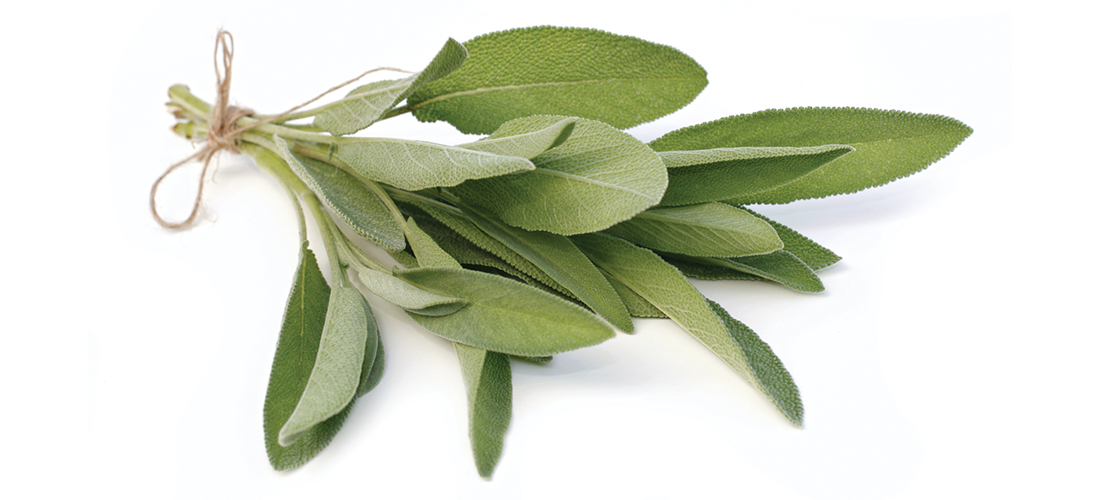
Sage Advice
It’s for more than just stuffing
By Jan Leitschuh
Sage, common culinary sage, is having a “moment” in creative cookery. Yet most of us still associate this undemanding, wooly gray-green herb with the Thanksgiving feast, as the classic, earthy seasoning for stuffing.
Or, of course, you could just use it to ward off negativity and unwelcome spirits. Long used in Native American and other cultures around the world, a smoky sage smudging is considered a space-purifying ritual. (Though white sage is most common, according to many sources, good old common sage will do the trick, too.)
There are many beautiful sages in the salvia world, with over 900 species in this mint-family member. Some are grown for flowers, texture and bulk in the garden.
But it’s November. In this season of harvest and feasting, common culinary sage is worth a closer look.
Or is it common?
Besides the classic evergreen perennial herb with the woolly, grayish leaves, you can also find other, more colorful varieties at some garden centers, such as green-gold, white-edged, curly, purple-leaved and tricolor culinary sages. All add texture and interest to the garden, with an edibility bonus.
There are still more edible sages, such as pineapple sage, whose lovely golden leaves and spiky red flowers are beloved by hummingbirds, butterflies and gardeners late summer to frost. But this sage grows faster and much larger than the common sage, reaching 3-4 feet in a single season. As the name suggests, the scent and flavor are reminiscent of pineapple. Fresh leaves are edible, and can be interesting in salads, or dried for a delicious tea.
Sages like our Sandhills soils, but our humidity? Less so. Air circulation will keep it happy. Sage likes a well-drained soil, preferably with a bit of compost worked in before planting. Attractive spikes of purple flowers appear in mid-summer, which attract birds, bees and butterflies. Prune plants back in the spring just as new growth resumes. Harvest leaves through the season as needed. This will keep the plant bushy. Since this resinous herb is evergreen in most zones, you can harvest sage well into late fall.
But how do we use thee? Let us count the ways . . .
First of all, there’s sage toothpaste. Truly. Google it if you don’t believe me. Apparently, studies show that sage contains over 60 useful compounds, many of which are beneficial to the mouth and gums, significantly decreasing mouth ulcers and inflammation of the gums.
Sage also has potent antibacterial, antifungal, antiviral and antimicrobial properties that help destroy cavity-causing bacteria and neutralize microbes that promote dental plaque. Sage also contains healing compounds that ease coughs and accelerate the healing of wounds, helping to soothe sore, swollen or bleeding gums.
Who knew?
A tea made from two tablespoons of dried or fresh sage is said to provide relief from teeth- and gum-related problems such as toothache and sore or swollen gums. (Brew the sage for a few minutes in boiling water, cool for 10 minutes. Swish in the mouth for 30 seconds and spit. Or, enjoy a cuppa.) A sage tea bag can also be placed on the gums to soothe the aching or inflamed area.
But it is the foodie aspects we wish to look at in this season of eating.
First off, meat. Sage was traditionally added to fatty meats. Sage is what makes breakfast sausage so unique in its taste. You can make your own breakfast patties and control the quality, adding a tablespoon of minced sage to a pound of ground pork sausage, also working in some red pepper flakes to taste, a teaspoon each of salt and brown sugar, half a teaspoon of black pepper, perhaps a pinch of cloves or marjoram.
Grilling out? Chicken bathed in an olive oil marinade with chopped sage, lemon balm, oregano, garlic, onion and thyme can lend a flavor similar to lemon herb chicken, say fans. The leftovers can be almost better!
A crusty Parmesan-sage pork chop with a dollop of homemade spicy applesauce on the side can warm up a fall supper. There are a number of such recipes on the internet.
I put sage in with roasts and most of my stews and simmer-dishes, along with other garden herbs like oregano, thyme, rosemary, celery and basil. Why wait for stuffing the whole turkey? I love cooking sage with ground turkey for quiche, or you could use in shepherd’s pie. Or just go ahead and make some dressing — comfort food for a late fall evening.
Foodies favor their sage leaves fried in brown butter until crispy. Garlic is a common addition. From there, they might toss the buttery mix in with ravioli, in a white wine cream sauce, with pierogi or boiled cheese tortellini.
Others use the fried leaves on top of butternut squash soup — or any soup, for that matter. Another seasonal pairing is oven-baked sweet potatoes, or better yet, baked sweet potatoes and apples. Still others enjoy the fried sage leaves with a beet and goat cheese salad with balsamic vinegar.
A chicken or veal saltimbocca is common in Italian trattorias. The meat is enveloped in a tasty wrap of fresh sage leaves and thin slices of prosciutto. Again, recipes abound online.
Or, to cure what ails you, nothing is better on chilly days than homemade chicken noodle/rice soup with fresh sage. Others go the sweet-savory route, infusing honey with sage and adding to teas.
A sage chimichurri — a green Argentinean pesto-like sauce traditionally made with parsley — can be used as an accompaniment to spinach-stuffed mushrooms, fish, meats or pork sausages. (See recipe below.)
For all its culinary and medicinal properties, common sage should not be ingested in large amounts for a prolonged period of time, say, as essential oils or large quantities of tea. Sage contains small amounts of thujone, a neurotoxin also found in the notorious 19th century liqueur absinthe, thanks to the wormwood used in the recipe. Oregano also contains minute amounts of thujone.
Apparently, thujone is mildly psychoactive. Van Gogh and Picasso were big fans back in the day, claiming inspiration from absinthe. Thujone is actually found in many plants used in cultural spiritual rituals to enhance intuition. (So, back to the whole smudging thing.)
But the amounts ingested in seasonings, flavorings and smudgings are quite minute. Studies have shown three or four cups of sage tea do no harm, although if you have an existing condition that affects the kidneys or liver, or you’re taking some medications that may interact with thujone, you may wish to proceed with some caution and awareness.
If you wish to deploy the culinary benefits of this simple garden herb, perhaps start with the classic dinner sauce chimichurri, adapted for sage. Smudging optional.
Sage Chimichurri
1/4 cup sage leaves and stems, minced finely
1/4 teaspoon red pepper flakes
1/2 teaspoon salt
1 clove garlic, peeled and crushed or minced
1 tablespoon red wine vinegar
1 tablespoon water
3 tablespoons oil
Mix ingredients well and use as a marinade, or serve in a bowl as an accompaniment to spoon over pan-seared fish, sliced flank steak, stuffed mushrooms, grilled meats or pork loin. PS
Jan Leitschuh is a local gardener, avid eater of fresh produce and co-founder of Sandhills Farm to Table.





